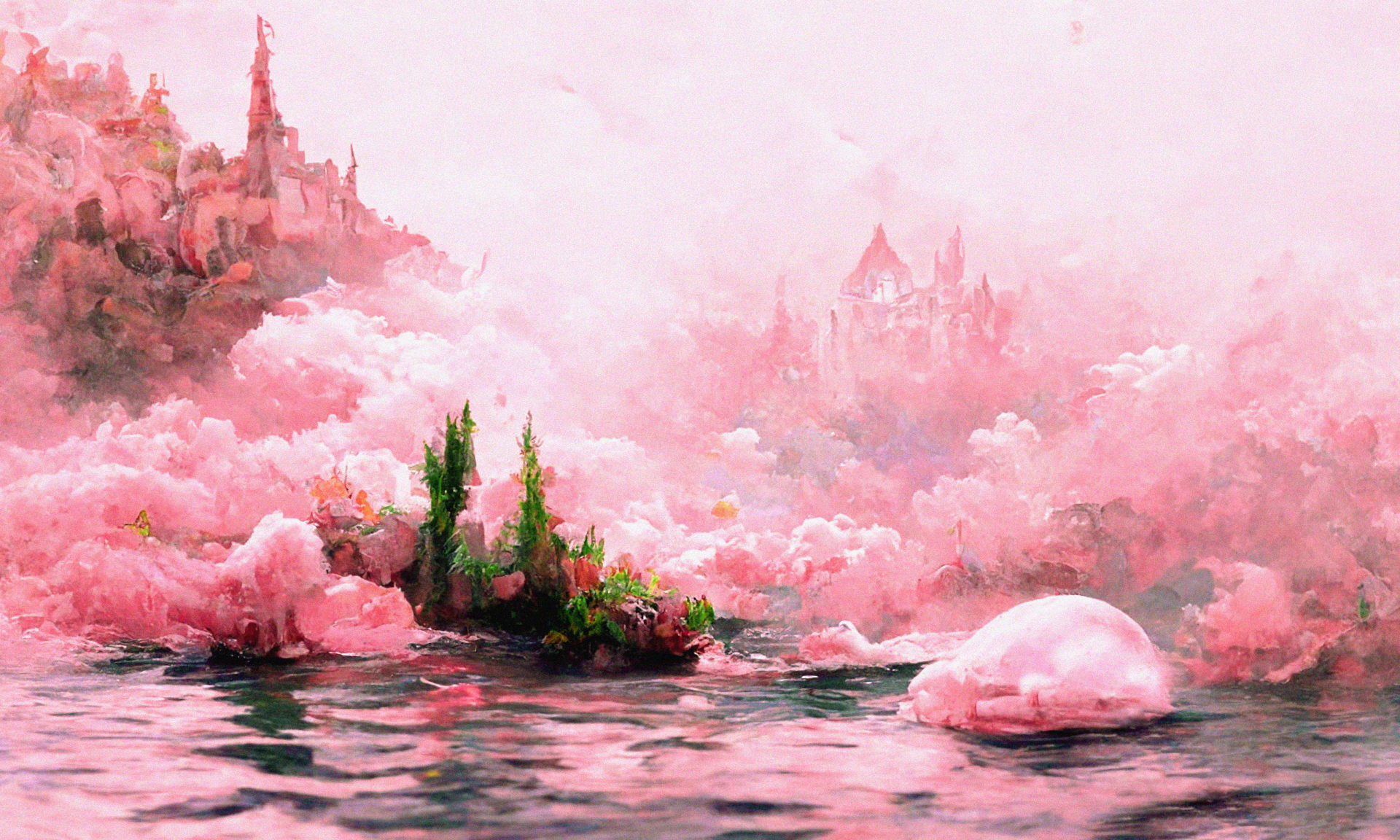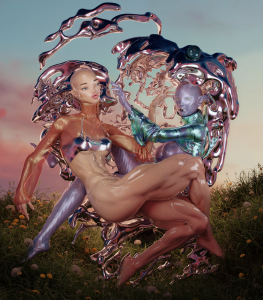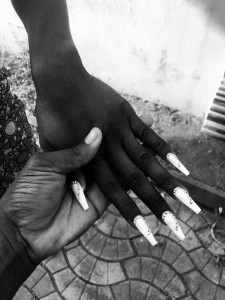Centre Pompidou
Curators Marcella Lista and Philippe Bettinelli discuss the museum’s landmark acquisition of NFTs.

Decentralized models for new networks of care are evolving, and communities are finding innovative ways to steward collective histories and build support systems. One such venture, the recently founded Queer Museum of Digital Art, operates as both an archive and a network of support and resources. One of the leaders of the initiative, Zak Krevitt, spoke with Outland to discuss the importance of increasing visibility for queer and trans artists, and how QMoDA is using technology to amplify community voices and record their history.
QMoDA is a preservation effort above everything else. We’ve seen so much art made by queer people lost to time, hate, disease, and cultural erasure. As an activist in the queer community, I often hear about the art lost during the AIDS crisis. Friends and family were given the responsibility of shepherding the creations of their loved ones. When work actually did make its way into institutions, it was not always safeguarded for the long term. Physical institutions also present a steep barrier to entry. When I started preserving my own artwork on the blockchain—largely due to censorship on centralized platforms—and learning more about the methods of provenance and royalty systems through smart contracts, I realized this technology could be used to preserve queer art and culture in a new, more robust way.

When I first entered the web3 space, I could count on one hand the number of queer and trans artists with high visibility and financial success in NFTs. Gossamer Rozen, Klara Vollstaedt, Kate The Cursed, Sam J, and Fewocious—they were trailblazers, but they still encountered transphobia and discrimination. Trans and queer creators were still wildly underrepresented in the NFT landscape.
The more time I spent in the space, I realized that art trends and major purchases were being determined disproportionately by people with exposure to vast sums of cryptocurrency, a position that was largely occupied by straight white men, who may not be inclined to seek out or support art made by trans and queer people. What they considered “good art” was usually work that existed in their own echo chambers of taste and online content consumption. QMoDA seeks to correct this underrepresentation by becoming a beacon in the space, uplifting and financially supporting trans and queer artists. We want to become a place of discovery where all collectors and enjoyers of art can come to find new work that they otherwise would not be exposed to. We also want to educate collectors outside of the web3 space on the work being created here.
A lot of people in the community had a hard time connecting their IRL support groups with their online work. In extreme cases, trans and queer artists were shunned from their social spaces over their association with NFTs and cryptocurrency. QMoDA really started out as a Twitter group chat, where I brought folks together to create new connections within the space. It was part group therapy, part tech support, and part retweet requests, but it was mostly a space to discuss everything that was going down. Having someone who understands what you’re experiencing can help you feel safe and supported. The need for a queer-friendly space inspired me to create QMoDA.
Our first successful acquisition was Laurel Charleston’s At the Surface (2021), a prismatic exploration of her signature style. She’s a makeup artist who uses her own body as a canvas to explore identity. We acquired the piece as a community using PartyBid, which fractionalized the artwork into ERC-20 tokens that were distributed proportionally to contributors. This early success at community action invigorated us, and things began to grow from there. The collector Sashaku then donated Crossroads (2022) by Jason Ebeyer and Jonathan Puc to the museum. It was an incredible moment in the organization’s formation, and the perfect piece to represent what we’re doing. It’s a collaboration between two artists depicting two fluid figures floating in a tender and loving embrace. The spirit of the two artists merge to create something more than the sum of their individual parts. That’s what we’re trying to do: bring trans and queer people from around the world together to grow our strength, build new bonds, and stand together in our power.

We’re still expanding our structural model. Currently, collection is led in part by our community via Discord nominations and votes, and in part by curators like Sky Goodman and myself. We’re planning to bring on more curators over time to foster a wider representation of voices when making purchases and selecting works from our vault for exhibitions. In the near future we’ll introduce governance tokens and other web3-enabled structures of collective ownership structures. We are partially decentralized for now as we put systems in place to move to full decentralization. I’ve worked in DAOs previously, and I’ve seen the pitfalls of rapid decentralization, so we are taking things slowly to ensure long-term growth and stability.
Artworks in our collection are there permanently. We’re making further strides toward an active and robust preservation effort that goes beyond simply holding the NFTs in our wallet, from pinning our own files and running our own IPFS nodes to gathering information from the artists about intent and display to account for future shifts in exhibition technologies. Another big push toward a broader approach to queer cultural preservation is reaching out to artists making work that isn’t web3 native, or even digitally native, to show them how to use Manifold or another custom contract tool so they can mint their own works that we can then steward. We think it’s important for creators to mint from their own wallets, to ensure provenance can always be traced back to them.
So far our collecting efforts have been made possible by a group of artists known as The Orbies, who minted portal-inspired artwork and donated the subsequent funds to us, as well Farokh and the Rug Radio community, who rallied together to raise money to support queer causes after the homo- and transphobic tirade of a prominent member of the ENS team. We’re hoping to raise more funds in the future to be able to continue supporting artists through NFT purchases, grants, and educational resources.
Art education can often be prohibitively expensive, but Dawnia, aka LetsGlitchIt, is an artist who has been sharing knowledge about glitch art practices and digital structures since the beginning. She’s the mother of the popular types of glitch art in use today. She uses glitch in an elevated and conceptual way, going beyond the surface to the metaphysical implications of the rejection of hegemony and prescribed gender categories. We make a concerted effort to collect both new and historic works of hers. One of our earliest acquisitions of Dawnia’s is the video How To Make Glitch Art (2021), which is representative of her legacy of knowledge-sharing while also providing a glimpse into her mind. It’s a rhythmic journey through space and time that explores the personal, the psychedelic, and the demolition of existing limitations.

Matthew Blaise’s photograph The Holy Fingers (2022) is a work that also represents the extensive breadth of our collection and the possibility for art to transcend a fixed medium. Blaise is a prominent activist for queer lives in Nigeria and other regions of Africa, where this kind of advocacy work can mean jail time or worse. They became interested in the web3 space to find ways to help the trans and queer community in Lagos. The photograph was taken during this activism work, as Blaise was comforting a trans woman who had just suffered a transphobic hate crime; the image shows them holding hands. It symbolizes what their community faces, and Blaise’s work to provide food, safe housing, and resources for trans people.
Espuma da Vida by Leonidas Valdez is an AI-generated landscape. As queer people, we’re often in situations where we don’t feel safe or lack control. Using AI to imagine utopian spaces queers space and time, allowing us to insert ourselves in idealized places that we have more authority and ownership over.
We didn’t want to call QMoDA a Museum of “queer art” because that term can be very limiting. The institution itself is queer—it’s powered by queer and trans people. Due to the nature of malleable or anonymous identity online, there may be some cases where we’re unsure of the artist’s gender identity or orientation. But a queer approach means rejecting the rigidity of traditional structures and embracing an expansive understanding of the universe. We’re working toward a collection that represents this vision of the world, and one that empowers historically marginalized communities through visibility, education, and financial support.
—As told to Lauren Studebaker
